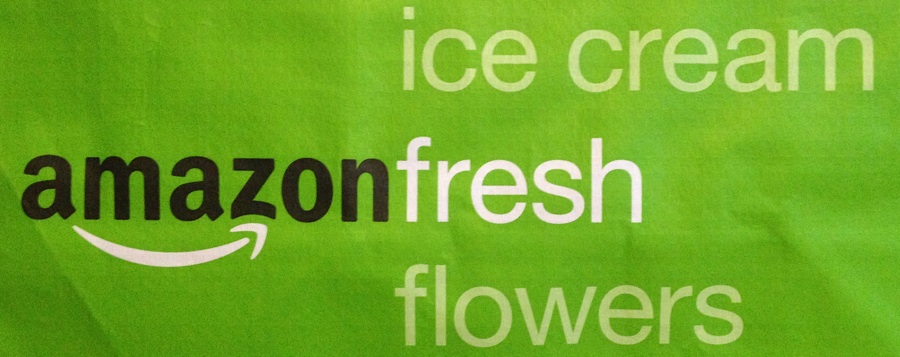
Everpix is a subscription photo service that promises unlimited online storage and automatic organization.
Short Review… It does the first part, storage and sync, perfectly. The second part is still a work in progress.
Much Longer Review…
The Life and Death of iPhoto

If you want to see what a perfect photo collection looks like, just visit an Apple store. On each display computer, you’ll find a copy of iPhoto, pre-set with Apple’s idealized vision of a family photo library.
Apple’s sample library is organized along every axis. Each image is tagged with Events, Albums, Faces, Keywords, Locations, and even a Five-Star Rating scale. Each sample album is an idyllic vacation or outing, populated exclusively by beautiful, multicultural families who never take bad photos and whose trips happen in confined locations, with no stranger’s faces in the background.
This is the dream world of iPhoto, as well as its mission statement: All of your photos, organized.
But throw a real family with real photos at the program and it chokes on every word of that statement.
- It can’t handle all of your photos because there are too many of them and they’re too big. You’re taking 8-megapixel pictures and shooting 1080p video with your iPhone. And god forbid you shoot a DSLR in RAW format. Suddenly that 128GB SSD hard-drive in your Macbook Air is full and you’re rationing photos to save space.
- And once your photos are in iPhoto, they’re no longer your photos. iPhoto buries them in its own convoluted file system. It only begrudgingly lets you share them using aging plug-ins to services like Facebook and Flickr.
- And it’s not organized unless you obsessively do the work of tagging every photo yourself. I like to imagine that the fictional mom in Apple’s sample iPhoto library is suffering from OCD. Are you coming to bed honey? “One minute! Just need to rate all the vacation photos on a 5-point scale!”
Everpix: F**k Organizing
The goal of Everpix is simple: All of your photos. That’s it.
Everpix gives up on the idea that anyone is going to organize anything. The service is a giant, bottomless bucket into which you quickly and easily dump every photo you take.
If the service had a motto, it would be “Upload Everything and Let God Sort It Out.”
Yes, Everpix claims to organize your photos automatically, but this is happy talk. A fantasy.
We’re developing image analysis technology that understands your photos and helps you manage your collection.
We’re building new ways for you to enjoy and rediscover your pictures.
Notice the present progressive tense (“-ing”). Automatic organization is something they’re working on, but what’s in the product right now is at best a proof of concept.
Everpix hides duplicate photos, tries to guess which photos you’re most interested in, and tries to categorize photos by broad categories like People, Nature, Food, etc. It doesn’t do any of these things particularly well or accurately. But that’s okay.
Because what Everpix does do is great. Everpix syncs, stores, and displays decades of photos quickly and effortlessly.
Install the Everpix app on your computer and your phone, and soon every photo you’ve ever taken is available everywhere. Despite the complete lack of organization, Everpix’s approach has put me in touch with more old photos in a week than iPhoto did in a decade.
Like this hilarious, random New York couple in 2004:

Or my little brother-in-law’s smile in 2007:

I hadn’t seen either of these photos in years. Probably not since they were taken.
Alternatives
- Flickr now offers one terabyte of free storage, but that number is more of a dare than reality. As in “I dare you to somehow manually upload one terabyte of photos when our service caps each upload session to 200 photos.”
- Facebook is designed for sharing. It’s great at that task, but it doesn’t keep high quality copies of your photos and it’s impossible to use the service without sharing everything.
- Dropbox has added some fantastic photo sharing and photo album features. But I have 70 gigs of photos going back a decade. At current prices, that means spending $100-a-year and eventually $200-a-year once I add another 30 gigs of photos.
- iCloud Photostream is barely a photo service. It’s useful in that it quickly moves photos from one device to all of your devices, but it only stores your last 1000 photos and cannot be upgraded or relied upon.
Conclusion
Everpix is a solid service. They offer 18 months of photo storage for free and unlimited photo storage for $49-a-year. The website and iOS apps are barebones, but each is being rapidly updated.
Having all of my photos backed up and instantly accessible is well worth the price of admission. Any other features they add over the next year are gravy.
Update: November 14, 2013
Sadly, Everpix has announced that they are shutting down and refunding their customers’ money. The Verge has a longform piece on their final days as a company.
Though I did not use Everpix every day, I loved the security that came with knowing all of my photos were being synced continuously and effortlessly to the cloud. I also loved being able to dig out a photo from years earlier whenever I wanted using their web and iOS applications. As of now, I have no idea how I’ll replace the service.
Free space on Dropbox is worth its weight in gold. You get to keep it forever, and every additional megabyte postpones the day when you’ll have to switch to their $100-a-year paid plan.
Thankfully, this week Dropbox is giving away free space if you try their iOS Gmail client, Mailbox (also free). If you have an iOS device, download the app, go to settings, and link it to your Dropbox account. You get the free gig of space immediately.
I struggle to work in silence. My mind gets crowded with ideas. But I also struggle to work with music. My mind begins to follow the lyrics.
Ambient noise is a way to drown out your thoughts without distracting your focus. Here are three tools I recommend:
SimplyNoise
SimplyNoise is a site that plays white, pink, and brown noise. There are many sites and many apps that do this, but in my opinion, SimplyNoise has the “cleanest” noise. I find other digital noise generators to be harsh or grating. Other generators also tend to loop in distracting ways.
If you don’t like using an iPhone app or a web browser to play the noise, you can pay a dollar to download a 60-minute MP3.
Pros:
- Creates an intense sense of focus.
Cons:
- Difficult to use alongside music. The noise is quickly overwhelmed by the lyrics.
- Eventually drives you insane, like being locked in a hyperbaric chamber.
Get Work Done Music
Get Work Done Music streams fast-paced music from SoundCloud. The songs tend to be electronica/trance music, usually with pulsing rhythms.
Pros:
- Variety.
- You might actually discover artists that you like.
Cons:
- Depends on accurate SoundCloud tagging. Sometimes you get crazy demon-screaming garbage.
Coffitivity
Coffitivity is a site that plays coffee shop noises on a loop. This feels like a dumb idea. But when combined with music, it provides a pleasing mix of noise that is just enough to balance out your music’s lyrics while still drowning out stray thoughts.
If you don’t like using a web browser to play sound, you can just download the MP3.
Pros:
- You can play your own music.
- You don’t feel like a total psychopath.
Cons:
Dr. Gay Hitler, son of George Washington Hitler, was a local dentist, serving our community from 1922 through 1946 from his office on West Main Street.
Jonathan Chait highlights a great local newspaper story about the pioneering Hitler family of Pickaway, Ohio. A significant portion of the town is named after these honest, All-American, salt-of-the-earth Hitlers, and the townsfolk are tired of everyone thinking they’re fans of the slightly more famous Adolf Hitler.
Seven previous studies had already shown that vitamins increased the risk of cancer and heart disease and shortened lives. Still, in 2012, more than half of all Americans took some form of vitamin supplements. What few people realize, however, is that their fascination with vitamins can be traced back to one man. A man who was so spectacularly right that he won two Nobel Prizes and so spectacularly wrong that he was arguably the world’s greatest quack.
Ouch. The Atlantic has a brutal book excerpt from Dr. Paul Offit tearing into the vitamin supplement industry. This is the same Dr. Offit who attacked the fake link between vaccines and autism in an earlier book.
I’ve always treated vitamins like a reassuring and benign superstition. “I don’t feel well, I guess I’ll take some vitamins!” “I could use a pick-me-up, I’ll drink some Emergen-C!” “My penis isn’t long enough, I’ll inject some Ostrich estrus!” (Okay not the last one.)
Offit’s article really shocked me.
Rebuttals
There has of course been pushback. Dr. Paul Jaminet, an astrophysicist who writes diet books, has a measured response. He takes issue with the specific studies cited by Offit, in particular an Iowa study which suggested that vitamins increase mortality (ie make you more likely to die) did not adjust for age. It compared older people who were taking supplements with younger people who were not.
The most compelling criticism is that the book excerpt blurs the line between taking a simple multivitamin and overdosing on Vitamin C because you think it’ll help you shoot lasers from your eyes. In an online interview with The Guardian, Offit explains the distinction in less sensationlist terms:
Other people think: “Because I’m not sure I’m getting all my vitamins, let me just take take a multivitamin every day” – which is OK. Multivitamins contain at or about the recommended dose of vitamins for that day. But then there are some people who believe that more is better – that by taking large quantities of daily vitamins they will do even better, live even longer and decrease the risk of cancer or heart disease. But in fact, many studies have shown that the exact opposite is true – that if you choose to take these large quantities of excess vitamins, then you increase risk of cancer and heart disease and shorten your life.
The bottom line: There just isn’t much compelling evidence about vitamins despite decades of study. They make sense on an intellectual level, but the benefits are not clearly visible in repeatable studies. A well-formulated multivitamin is probably benign and not doing you any harm or good either way.
Matt Singer at Dissolve has a sharp post on the rise of Europeans doing flat American accents in blockbuster films:
Bale is from the United Kingdom as well, and variations of his flat, husky whisper—like a guy with a bad case of laryngitis and a mild speech impediment—have become the de facto “American” voice for a lot of foreign born Hollywood action heroes. Scottish Gerard Butler used it earlier this year as a Secret Service agent in Olympus Has Fallen; Australian Sam Worthington deployed it with varying degrees of success in Avatar and Terminator Salvation.
What annoys me most about this particular fake accent is that it robs characters’ voices of depth and subtlety. Pacific Rim is a tremendously fun and goofy film, but its lead character has the vocal range of a robot. Jokes and important moments feel off because the actor is stuck talking like a stoic, Clint Eastwood cowboy rather than like a real person.
I’m not opposed to Brits and Europeans doing American accents, but the Bale voice is simply too flat and dreary to work for most films.
The “respectable” thing to say about people like Paul or the late Barry Goldwater, I suppose, is simply that they are ideologues rather than people driven by some kind of racial animosity. But I think it’s selling free market ideology short to suggest that government regulations meant to undue the outcome of a century long campaign of terrorist violence is just a straightforward consequence of a general support for free enterprise. You need to combine that ideology with a sincere indifference to black people’s welfare to reach that conclusion, just as you need to combine Paul’s ideology with genuine indifference to the history of race in America to reach Paul’s conclusion about democracy’s relationship to Jim Crow.
Matt Yglesias wrote an excellent post last month about Rand Paul’s foot-in-mouth statements opposing the 1964 Civil Rights Act. Jonathan Chait covered similar ground in a 2012 post about Rand’s father, Ron Paul.
Ron and Rand Paul are beloved libertarian figures on the internet because they follow libertarian philosophy to some of its more progressive conclusions, like reducing defense spending and decriminalizing drugs. In this and a few other areas, they give loud and passionate voice to sensible solutions drowned out by mainstream politics.
But it’s worth remembering that libertarianism in this country has often been driven by racism rather than ideology. This is not to say that all libertarians are racists or that libertarianism is an inherently racist philosophy, but when I read about Ron Paul’s racist 1990s newsletters and Rand Paul’s aide’s racist, secessionist writings, it becomes harder and harder to square the internet’s hero worship of these men with the actual motivations guiding them.
Google recently shut down Google Reader, their RSS syncing service. Here’s a quick look at three replacements:
Feedly
Feedly is the most popular Google Reader replacement because it’s free and fast. But a few key problems prevented me from choosing it.
Feedly has a closed API. I have custom scripts and hacks I use for my RSS, and they require an open API.
Feedly also has no clear business model. Free is great, but after Google Reader’s epic flameout, it’s hard to trust a service that doesn’t ask for money.
And finally, Feedly’s website and apps are over-designed and confusing. Feedly seems desperate to become Flipboard, so their default layout is a magazine-style look at your RSS. You can switch to a “titles only” view that looks more like Google Reader, but you still have to deal with bizarre gestures and interactions in their iOS apps.
Despite these criticisms, Feedly is a strong service. If they open up their API, I’ll consider switching to them and just using third-party apps to access the service.
Feed Wrangler
Feed Wrangler is a small, paid RSS syncing service created by iOS developer David Smith.
Several writers and programmers in the tech community sing the praises of this service, but I couldn’t get over two things: No free trial and an ugly, ugly, ugly website.
Feedbin
Feedbin is a small, paid RSS syncing service created by Ruby on Rails developer Ben Ubois. It’s $30-a-year, has an attractive website, and an open API.
Winner: Feedbin
Feedbin is my new RSS reader. For now. The RSS market is changing fast, and I expect to revisit my choice a year from now when it’s time to renew my subscription.

Amazon Fresh is Amazon’s new grocery delivery business. They’ve just expanded to Los Angeles and offered Prime customers a 90-day free trial (the regular price is $300-a-year).
I’m interested in the service because I’m lazy and find supermarkets overwhelming. My wife is interested because she likes planning meals and tracking calories.
Here are our first impressions.
The Good
Amazon Fresh promises same day and next day delivery, which is amazing. The minimum order is $35, which is low enough that you can replace a big weekly grocery store visit with two small orders during the week. You can place your order at night after work, then wake up in the morning to find your food on the doorstep in neatly packed bags.
Fresh also offers nutritional information for many items on their site as well as seasonal recipes. You can even order high end items from local specialty shops, like fresh fish from Santa Monica Seafood.
The customer service is great, responding almost instantly to any inquiry or problem.
The Bad
But Amazon Fresh feels like shopping at a Whole Foods connected to a Costco. You want some tuna? Great! You can have this ultra high quality organic brand for three times the price! Oh, you want your regular cheap brand? Okay, here’s a 75-pack of Bumblebee tuna cans for $90!
The economics of home delivery cause the service to offer either high-end brands at high prices or the regular brand in massive quantities, with little in-between.
Fresh.Amazon.com is a bad, sloooooow website. It’s shockingly bad. Amazon isn’t just the world’s biggest Internet retailer, they also operate a massive cloud server and cloud hosting service. But just logging into this site takes 15 to 20 seconds.
In addition to being slow, the website does a poor job of reliably communicating which items are available when. Orders placed for the next morning will often arrive with items missing. There is no notice inside the packaging itself, instead you receive an email which says “The following items were not delivered: “ and then nothing is actually listed. If you’re dedicated you can go to the website, log into your past orders, and see which items were mysteriously left out. The site has no mechanism for rolling over a missing item to a future order. The items are just gone, leaving you to find them again in the search system, re-add them to your cart, and just hope that it works out next time.
Odds & Ends
- Prices on Amazon Fresh are just okay. They’re not as good as your local market’s sale prices but not as bad as MSRP.
- Fresh includes same day and next day delivery on over 500,000 Amazon Prime items. It’s only a small subset of Amazon’s usual offerings, but you can buy household items like a surge protector with nearly instant shipping.
- Amazon failed to deliver half of one of our grocery orders. The customer service not only called me but refunded the entire order, including the more expensive items that they did successfully deliver.
- Fresh deliveries arrive in charming green tote bags. Oddly, the service doesn’t do a good job combining similar items. So you might have two big coolers arrive, each packed with dry ice and each only carrying one tiny frozen item like a bag of peas or a pack of popsicles.
Conclusion
Right now, Fresh does not feel like the future of groceries. It feels like a side project. Perhaps a hobby receiving only Amazon’s barest attention and focus. While using the service, I’ve already had to hop out to my regular market twice just to replace items missing from my orders. Combine that with the slow website, and Fresh just hasn’t offered me the convenience necessary to justify the increased cost over my local market.
But I’m glad that Amazon Fresh has a 90-day trial. If my trial were ending today, I would not renew the service. But I have nearly two months of free grocery delivery left, and I think a lot of these problems are fixable. I’d love for this service to work out, and I’m going to continue to send feedback to Amazon’s excellent customer service in the hopes that they’re out there listening.

I did not like Man of Steel. If you want to know why, I recommend two posts about the film:
But I do want to touch on one idea that I haven’t seen explored much in reviews of the film.
Good Action Requires Consequences and Character
A common defense of Man of Steel is that it has “good action.” The movie has huge special effects sequences, featuring superpowered fist fights, flying dragon-butterfly monsters, laser eye-battles, etc… In short, superhero battles on a level never before attempted.
And all of that action is boring.
Man of Steel lacks original or inventive ideas for its superhero fight scenes. Characters line up and punch and hit each other through building after building. “Pow! Superman crashes into a bank vault!” “Blammo! Zod plows through a gas station!” The spectacle entertains for about fifteen minutes, but the movie never finds a second gear. Superman and Zod are invulnerable. There are no consequences to each punch or each moment in any particular fight scene. Perhaps sensing this problem, the movie tries to blow up bigger and bigger buildings.
The action scenes also lack character. We rarely understand the personal stakes in each fight. Superman has an elaborate brawl with three Kryptonians that destroys his home town of Smallville and at the end… Nothing. The villains just fly away because they got tired of fighting. That’s because there is nothing at stake in the scene for them. The characters simply fight to fight.
What’s so sad about this is that fun goofy action shouldn’t require you to turn your brain off or ignore the story. Just look at the batpod sequence in The Dark Knight:
The Dark Knight batpod sequence is much, much smaller than even the opening action scenes in Man of Steel, but it feels grounded and visceral. Harvey Dent, a character we’ve spent significant time with, is in mortal peril after bravely standing up to the Joker by claiming that he is Batman. If the Joker kills Harvey, the city will be thrown into further panic and chaos. Also in the audience’s mind: Harvey and Batman are competing for the same woman, Rachel, so Batman saving Harvey will have significant personal consequences.
But forget all that character shit. Isn’t this sequence fucking fun!? Batman reveals his batmobile can turn into a crazy sideways motorcycle, races across Gotham, drives through a mall, plays chicken with a semi-truck, swoops under the truck, flips the truck AT-AT style, then drives up a wall to turn around? HOLY SHIT THAT WAS COOL.
I defy anyone to find one sequence in Man of Steel even half as unexpected and entertaining as this Dark Knight sequence.





